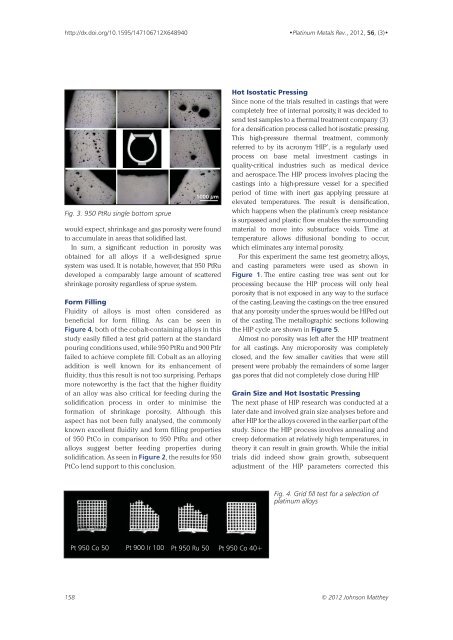Download article PDF - Platinum Metals Review
Download article PDF - Platinum Metals Review
Download article PDF - Platinum Metals Review
You also want an ePaper? Increase the reach of your titles
YUMPU automatically turns print PDFs into web optimized ePapers that Google loves.
http://dx.doi.org/10.1595/147106712X648940<br />
•<strong>Platinum</strong> <strong>Metals</strong> Rev., 2012, 56, (3)•<br />
Fig. 3. 950 PtRu single bottom sprue<br />
1000 μm<br />
would expect, shrinkage and gas porosity were found<br />
to accumulate in areas that solidified last.<br />
In sum, a significant reduction in porosity was<br />
obtained for all alloys if a well-designed sprue<br />
system was used. It is notable, however, that 950 PtRu<br />
developed a comparably large amount of scattered<br />
shrinkage porosity regardless of sprue system.<br />
Form Filling<br />
Fluidity of alloys is most often considered as<br />
beneficial for form filling. As can be seen in<br />
Figure 4, both of the cobalt-containing alloys in this<br />
study easily filled a test grid pattern at the standard<br />
pouring conditions used, while 950 PtRu and 900 PtIr<br />
failed to achieve complete fill. Cobalt as an alloying<br />
addition is well known for its enhancement of<br />
fluidity, thus this result is not too surprising. Perhaps<br />
more noteworthy is the fact that the higher fluidity<br />
of an alloy was also critical for feeding during the<br />
solidification process in order to minimise the<br />
formation of shrinkage porosity. Although this<br />
aspect has not been fully analysed, the commonly<br />
known excellent fluidity and form filling properties<br />
of 950 PtCo in comparison to 950 PtRu and other<br />
alloys suggest better feeding properties during<br />
solidification. As seen in Figure 2, the results for 950<br />
PtCo lend support to this conclusion.<br />
Hot Isostatic Pressing<br />
Since none of the trials resulted in castings that were<br />
completely free of internal porosity, it was decided to<br />
send test samples to a thermal treatment company (3)<br />
for a densification process called hot isostatic pressing.<br />
This high-pressure thermal treatment, commonly<br />
referred to by its acronym ‘HIP’, is a regularly used<br />
process on base metal investment castings in<br />
quality-critical industries such as medical device<br />
and aerospace. The HIP process involves placing the<br />
castings into a high-pressure vessel for a specified<br />
period of time with inert gas applying pressure at<br />
elevated temperatures. The result is densification,<br />
which happens when the platinum’s creep resistance<br />
is surpassed and plastic flow enables the surrounding<br />
material to move into subsurface voids. Time at<br />
temperature allows diffusional bonding to occur,<br />
which eliminates any internal porosity.<br />
For this experiment the same test geometry, alloys,<br />
and casting parameters were used as shown in<br />
Figure 1. The entire casting tree was sent out for<br />
processing because the HIP process will only heal<br />
porosity that is not exposed in any way to the surface<br />
of the casting. Leaving the castings on the tree ensured<br />
that any porosity under the sprues would be HIPed out<br />
of the casting. The metallographic sections following<br />
the HIP cycle are shown in Figure 5.<br />
Almost no porosity was left after the HIP treatment<br />
for all castings. Any microporosity was completely<br />
closed, and the few smaller cavities that were still<br />
present were probably the remainders of some larger<br />
gas pores that did not completely close during HIP.<br />
Grain Size and Hot Isostatic Pressing<br />
The next phase of HIP research was conducted at a<br />
later date and involved grain size analyses before and<br />
after HIP for the alloys covered in the earlier part of the<br />
study. Since the HIP process involves annealing and<br />
creep deformation at relatively high temperatures, in<br />
theory it can result in grain growth. While the initial<br />
trials did indeed show grain growth, subsequent<br />
adjustment of the HIP parameters corrected this<br />
Fig. 4. Grid fill test for a selection of<br />
platinum alloys<br />
Pt 950 Co 50 Pt 900 Ir 100 Pt 950 Ru 50 Pt 950 Co 40+<br />
158 © 2012 Johnson Matthey
















